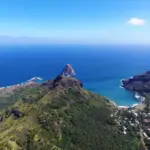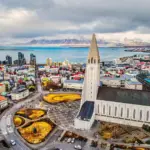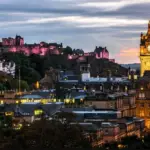
Mexico is a country full of mysteries and legends that fascinate visitors. Among the most curious destinations is Santiago Valley, located in the heart of the country, where seven inactive volcanoes form a unique geographical arrangement, similar to the constellation Ursa Major.
The contrasting landscape of the Santiago Valley, with its extinct volcanoes, rivers, lakes and lush vegetation, is an invitation to discover the cosmic secrets that this region hides. In addition to the mysteries natural, the area also holds traditions cultural and archaeological sites that further enrich the visitor experience.
Main points of this article:
- Discovering the charms of Santiago Valley
- The secrets revealed by aerial images
- THE cosmic connection between volcanoes and stars
- The history of the Santiago Valley
- Tourist attractions in the Santiago Valley
Discovering the charms of the Santiago Valley
The Santiago Valley is an extremely charming tourist destination. With stunning scenery, unique flora and fauna, and a local culture Rich and diverse, it's a place that captivates all who visit. Here, we present some of the valley's main attractions:
Enjoy the view from Mirador de los Pocitos
The Mirador de los Pocitos is a spectacular viewpoint that offers panoramic views of the Santiago Valley, its volcanoes, and the city of Guanajuato. It is a truly unforgettable experience. It's worth remembering that access is via a steep trail, so you need to be physically prepared.
Discover the archaeological site of Plazuelas
Plazuelas is a pre-Columbian archaeological site that was once an important ceremonial and political center in the region. There, you can see ruins of temples, plazas, and even a pelota stadium, a popular game at the time. It's a great option for those who enjoy history and culture.
Try the local cuisine
The cuisine of the Santiago Valley is a true delight for the senses. Typical dishes include enchiladas, chiles rellenos, and the traditional tamales. Also, be sure to try the fresh fruits and vegetables grown in the region, such as mamey, nopal, and guayaba.
Trails and hikes through the volcanoes of the Santiago Valley
The volcanoes of the Santiago Valley offer a variety of trails and hikes for those who enjoy outdoor activities. Each volcano has its own trail, with varying degrees of difficulty and length. It's a great way to explore the region and get some exercise at the same time.
Visit the House of Culture
Casa de la Cultura is a cultural center that hosts art exhibitions, workshops, theater performances, and other cultural events. It's a great option for those who want to learn more about local culture and participate in creative and educational activities.
These are just some of the many charms that the Santiago Valley has to offer. Don't miss the opportunity to discover this incredible destination in the heart of the Mexico.
The secrets revealed by aerial images
From aerial photographs of the Santiago Valley, several discoveries were made that reveal a cosmic connection between the arrangement of volcanoes and the constellation Ursa Major.
According to experts, the aerial images show that the location of the seven inactive volcanoes is similar to the arrangement of the stars that form the constellation, indicating advanced astronomical knowledge on the part of the ancient culture that inhabited the region. Some scholars believe that the positions of the volcanoes were purposefully constructed to mirror the positions of the stars.
That cosmic connection has been the subject of much speculation and questioning, leading scientists and interested parties to seek symbolic and mystical meanings for the volcanoes' location. Gradually, the secrets of the Santiago Valley are being unraveled with the help of technology and scientific research.
The secrets revealed by aerial images
| Title | Description |
|---|---|
| Position of volcanoes | The arrangement of the seven inactive volcanoes in the Santiago Valley coincides with the position of the stars that form the constellation Ursa Major. |
| Astronomical knowledge | This fact indicates advanced knowledge of astronomy on the part of the ancient culture that inhabited the region. |
| Cosmic connection | The cosmic connection between volcanoes and stars has been the subject of much speculation and questioning, leading scientists and interested parties to seek symbolic and mystical meanings for the arrangement of volcanoes. |
To the aerial images are fundamental to the study of the Santiago Valley and have helped to unravel many of its secrets. The cosmic connection between volcanoes and stars is just one of many mysteries that involve this fascinating region of Mexico.
The Cosmic Connection Between Volcanoes and Stars
The Santiago Valley is a place surrounded by a mystical aura and full of cosmic secrets that have intrigued scholars and astronomy enthusiasts for years. According to recent discoveries, there's a connection between the position of the Valley's volcanoes and the stars that make up the constellation Ursa Major.
This cosmic connection was revealed through aerial photographs that showed how the arrangement of volcanoes, when superimposed on the stars of the constellation, exhibits a striking similarity. The theory suggests that pre-Columbian inhabitants of the region made this observation and used the arrangement of volcanoes as a celestial map for their ritual and agricultural activities.
This connection between volcanoes and stars may also have a broader symbolic meaning. Some scholars believe that the arrangement of volcanoes and the constellation Ursa Major represent a reclining human figure, with its head pointing north and arms and legs outstretched. For them, this figure represents the cosmos and human nature, and the connection between volcanoes and stars unites these two aspects.

The volcanoes of the Santiago Valley and the stars of the constellation Ursa Major
| Volcanoes of the Santiago Valley | Stars of the constellation Ursa Major |
|---|---|
| The Fraile | Alkaid |
| El Ceboruco | Mizar |
| The Remedies | Alioth |
| The Sombrero | Megrez |
| El Zamorano | Merak |
| El Jorullo | Dubhe |
| El Tecolote | Phad |
This theory is fascinating and has attracted the attention of many people to the Santiago Valley. Besides being a place of unparalleled natural beauty, the Valley is now seen as a site of great historical and astronomical significance. This cosmic connection between volcanoes and stars is a reminder of how interconnected nature and the universe are, and how much we still have to learn about the world around us.
The history of the Santiago Valley
The Santiago Valley is a region full of history and rich traditions cultural heritage dating back to pre-Columbian times. The region's first inhabitants were the Purépechas, a pre-Hispanic civilization that left significant traces throughout central Mexico.
With the arrival of Spanish colonizers, the Santiago Valley underwent a significant transformation, with the introduction of new cultures and customs. During the colonial period, the region became an important silk and cotton production center, thanks to its favorable climate and abundant natural resources.
Over time, the Santiago Valley saw its economy diversify, with the emergence of new economic activities and the incorporation of new technologies. Today, the region is known for its rich cultural heritage, beautiful natural landscapes, and modern leisure and entertainment options.

Tourist Attractions in the Santiago Valley
The Santiago Valley is a true natural and cultural treasure in Mexico, offering a wide variety of tourist attractions for all tastes and ages. Among the main options, the following stand out:
Trails
The Santiago Valley is a paradise for hiking enthusiasts, with a variety of options ranging in difficulty and length. Some of the most popular trails are Cerro Grande, Cerro del Obispo, and Cerro de los Picachos.
Archaeological Heritage
The Santiago Valley boasts archaeological sites dating back over a thousand years, such as the Plazuelas archaeological site, which preserves the ruins of an ancient pre-Hispanic city. Other attractions include the Estrella Caves and the Tecolote Cave.
Observation Points
The Santiago Valley viewpoints are a great option for those seeking panoramic views of the region. Among the main observation points are Mirador de la Bufa, Cerro de Culiacán, and Torre de la Candelaria.
Cultural Activities
The Santiago Valley is a destination very rich in culture and traditions, and offers a variety of cultural activities for visitors, such as visits to ceramic factories, typical Mexican cooking classes and performances dance and music folkloric.
Parks and Nature Reserves
The Santiago Valley is a region of great environmental wealth, home to several areas of environmental preservation, such as National park Sierra de Lobos and the Pedernal Ecological Reserve. These locations offer visitors options such as rivers, lakes, waterfalls, and trails for nature lovers.
These are just some of the tourist attractions that can be found in Santiago Valley. Now that you know what to expect, be sure to plan your visit and discover everything this incredible destination has to offer!
The natural beauty of the Santiago Valley
The Santiago Valley is a true natural treasure, with a unique and surprising landscape that enchants visitors from all over the world. In addition to the arrangement of volcanoes that form the seven lamps, the place has a series of natural beauties that deserve to be explored and appreciated.
Volcanic formations
One of the main features of the Santiago Valley is its volcanic formations, which offer an impressive view of the strength and beauty of nature. There are countless craters, mountains, and rocky peaks, creating a breathtaking landscape that can be explored through hiking, climbing, and other adventure sports.
The lush vegetation
The region is also famous for its lush vegetation, which includes forests, green fields, and a variety of plant and flower species unique to the region. It's a spectacle in itself, changing seasonally and showcasing the region's natural richness. Santiago Valley.
Rivers and lakes
In addition to volcanic formations and abundant vegetation, the Santiago Valley also boasts rivers and lakes that visitors can explore and enjoy. These are perfect options for those who enjoy water activities such as fishing, swimming, and boating, and complete the scenery. stunning natural of the place.
For all these reasons, environmental preservation of the Santiago Valley is essential to ensure that future generations can also enjoy this natural beauty unique in the world. Visiting the Santiago Valley is to be enchanted by the perfection of nature and enjoy a moment of peace and connection with the world.
Local culture and traditions in the Santiago Valley
The Santiago Valley is a place that exudes culture and traditions in every corner, making it one of the region's greatest treasures. The cultural diversity of the Santiago Valley is a blend of pre-Columbian and colonial influences, resulting in a unique and charming atmosphere. Discover some of the main ways to experience the local culture and traditions in the Santiago Valley:
Typical gastronomy
Local cuisine is one of the most delicious ways to enjoy the Santiago Valley. Some of the most famous dishes include chile en nogada, a pepper stuffed with a mixture of meat, fruit, and nuts, served with a special sauce made with walnuts and pomegranate. Another dish much loved by locals and visitors alike is pozole, a corn soup with pork and typical Mexican spices, considered a sacred dish in some pre-Columbian cultures.
Craftsmanship
Crafts are an important expression of local culture and feature an interesting variety of handmade works and unique pieces. You can find beautiful tapestries, ceramics, wood carvings, and other decorative objects in shops and at fairs held at various times of the year.
Festivities
The Santiago Valley is known for its lively and traditional festivals. One of the most popular is the Feast of Santiago Apóstolo, the patron saint of the valley, held in July. During the festival, you can enjoy processions, dances, shows, and traditional foods.
Cultural manifestations
The Santiago Valley also hosts a variety of cultural events, including traditional dances, theater, music, and more. One of the most popular is the "Danza de los Viejos" ("Dance of the Old Men"), which takes place in December and represents old age and wisdom through traditional dances and costumes.

Visiting the seven luminaries of the Santiago Valley
If you're planning a trip to Mexico, you can't miss the Santiago Valley on your itinerary. Discover the seven lamps This magical place is a unique experience for those seeking contact with the nature and culture local.
To help you explore each of the volcanoes that make up the seven lamps from the Santiago Valley, we have prepared some useful information:
| Volcano | Access | Best time to visit |
|---|---|---|
| The Fraile | Access via the road connecting Guanajuato to Silao | From October to April |
| El Zamorano | Access via the road connecting Guanajuato to Irapuato | From February to August |
| The Sombrero | Access via the road connecting Irapuato to Silao | From January to July |
| La Bufa | Access via the road connecting Silao to León | From September to December |
| San Miguel | Access via the road connecting León to San Miguel de Allende | From March to September |
| Los Picachos | Access via the road connecting Guanajuato to San Miguel de Allende | From August to December |
| El Cubilete | Access via the road connecting Silao to Guanajuato | From May to November |
Each volcano has its own particularities and offers experiences different. Therefore, it's important to research and choose the ones that best suit your interests and skills. Some options include:
- Trails with varying degrees of difficulty, which can be explored on foot, by bicycle or on horseback.
- Natural viewpoints to observe the lush landscapes of the Santiago Valley.
- Archaeological sites, such as the Cerro de Gallo complex, reveal traces of the pre-Columbian civilization that inhabited the region.
- Gastronomic and cultural experiences, such as visits to local farms and wineries, which showcase the rich agricultural and wine production in the region.
Regardless of the itinerary you choose, be sure to respect the region's environmental and cultural preservation rules. The Santiago Valley is a place of historical and spiritual significance for Mexicans, and its care is essential to ensure that future generations can enjoy its beauty and cosmic secrets.
The mysteries and legends of the Santiago Valley
The Santiago Valley is a place full of mysteries and legends ranging from supernatural phenomena to hidden treasures. Check out some of the most curious stories about the region:
"They say that on the clearest nights, you can see a beautiful woman dressed in white dancing in the crater of the El Fraile volcano. Some claim she is an Aztec princess who fell in love with an enemy warrior, while others believe she is a bride who died before her wedding and now dances eternally in search of her beloved."
This is just one of the legends surrounding the Santiago Valley. Another famous story is that of the treasure hidden by the Spanish during colonization. According to legend, the treasure was hidden somewhere in the valley, and many adventurers have ventured in search of these riches.
In addition, there are reports of sightings of strange lights and unidentified flying objects in the region, further fueling the mysteries of the Santiago Valley.
Visit the Santiago Valley and discover its secrets!
- To explore the Santiago Valley and its legends, find a local tour guide and embark on an exciting adventure.
- Don't forget to bring the necessary equipment for hiking and walking, such as sunscreen, a hat, and water.
- But above all, respect nature and local culture, so that we can preserve this magical place for many years to come.
Conclusion
In the heart of Mexico, the Santiago Valley holds cosmic mysteries and a unique landscape that captivates tourists from around the world. The arrangement of seven inactive volcanoes in the shape of Ursa Major creates a connection between heaven and earth, inviting visitors to explore its secrets.
Beyond the seven luminaries, the Santiago Valley is a complete tourist destination, with natural, cultural, and historical attractions that thrill and surprise. The viewpoints, trails, rivers, and lakes attract nature lovers, while the typical cuisine, crafts, and local festivities provide an immersion into the region's culture.
To visit the Santiago Valley and experience all its charms, it's important to plan ahead and respect nature and the local community. Choosing the best times of year, hiring local guides, and following conservation guidelines are essential to ensuring a safe and unforgettable experience.
In conclusion, the Santiago Valley is a magical and inspiring destination that deserves to be discovered and appreciated. Each volcano, each landscape, each tradition holds a secret that contributes to the grandeur of this unique place in the world. Whether for a sightseeing tour, a family adventure, or a spiritual journey, the Santiago Valley is an invitation to explore and connect with nature and the universe.
FAQ
Where is the Santiago Valley located?
The Santiago Valley is located in the heart of the Mexico.
How many volcanoes make up the seven luminaries of the Santiago Valley?
The seven luminaries of the Santiago Valley are formed by seven inactive volcanoes.
What is the relationship between the arrangement of volcanoes and the constellation Ursa Major?
The arrangement of the volcanoes in the Santiago Valley coincides with the position of the stars that make up the constellation Ursa Major.
What are the main tourist attractions in the Santiago Valley?
The Santiago Valley has several tourist attractions, such as trails, viewpoints, archaeological sites and local cultural experiences.
What are the natural beauties of the Santiago Valley?
The Santiago Valley is known for its volcanic formations, lush vegetation, rivers and lakes, which make up its beauty natural.
What are the traditions and cultural manifestations present in the Santiago Valley?
The Santiago Valley has a rich local culture, with typical cuisine, crafts, festivities and other cultural events.
How can I visit the seven luminaries of the Santiago Valley?
To visit the seven luminaries of the Santiago Valley, you can follow specific trails and seek information on accessibility and the best times of year.
Are there any legends and mysterious stories related to the Santiago Valley?
Yes, the Santiago Valley is surrounded by legends and mysterious stories involving supernatural phenomena and hidden treasures.
How important is it to explore and preserve the Santiago Valley?
The Santiago Valley is important to explore and preserve because of its allure and cosmic secrets, as well as its unique setting in Mexico.
Lucas Wanderlust has a tireless spirit of adventure, always seeking new travel experiences. Fascinated by the world and the possibility of exploring unknown destinations, he fell in love with the sense of freedom and self-discovery that traveling alone provides. With a backpack on his back and a heart open to the unknown, Lucas embarks on exciting journeys, where each destination becomes a unique chapter in his life story. He gives himself body and soul to the magic of solo travel, inspiring others to follow in his footsteps and discover themselves through adventure.







